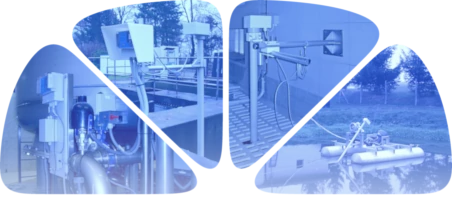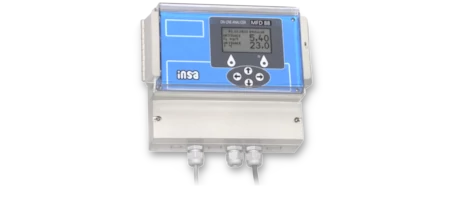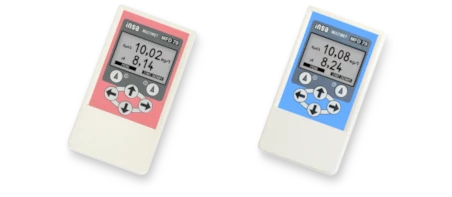Oxygen concentration: Sensors
Appropriate sensor is fundamental to any measurement setup. Variety of different types and variants are available, depending on the measured quantities, sensor dimensions, as well as usage workflow, environment, and installation method. The vast majority of sensors listed below are just components of a larger measurement setup, and can therefore be satisfactorily used only with a compatible analyzer. Sensors for in-technology measurements should be installed inside our probes, ensuring their fixing and protection, and these connect to a terminal block. Variants for laboratory and portable usage are terminated with the appropriate connector. Sensors generally have the shortest lifetime of the entire setup, due to direct contact with the measured medium.
Optical oxygen sensors CSOT63
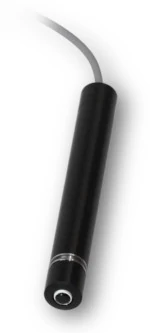
The CSOT63 variants are optical oxygen sensors designed to measure oxygen concentration in both liquids and gases, as well as temperature. An input block (with galvanic isolation) is integrated in the body of the sensor, allowing for connection to INSA analyzers, or directly to process control systems with a 4-20 mA analog input, with no further components.
These sensors are used to measure the concentration of oxygen at biological WWTPs, in surface or groundwater, in water-treatment technologies, fish farming facilities, etc. They are installed in open tanks or channels, suspended by the cable, usually using the MUT14 clamp. The working position must be chosen in such a way that movement of the suspended sensor does not damage it.
- The high level of protection (IP68) allows deployment directly in the technological process, without the need to use probes or other covers.
- Accurate measurement in both still and flowing water, thanks to zero dependency on flow rate.
- Smooth surface of the plastic membrane allows self-cleaning of the sensor in flowing water (typical for WWTP activation tanks) and thus lower maintenance requirements.
- Long service life of the sensor and the membrane head, with maximum simplicity of head replacement.
- Virtually no need for recalibration.
- Resistance to the effects of CO2, SO2, H2S significantly increases the reliability of measurements, especially in WWTPs.
| Type | Compatibility | Power supply | Output current |
| CSOT63-66 | Current loops 2x 4-20 mA with external power | 12 - 28 V DC, 2x 20 mA | Oxygen 4.5 - 20 mA (slope not calibrated) Temperature 6 - 18 mA (values 0 - 40 °C) |
| CSOT63-88 | The MFD88 analyzer | MFD88 interface | |
| Principle | Optical, quenching of luminescence by oxygen | ||
| Measurement range | 0.1 - 20 mg/l or 1 - 150 % | ||
| Resolution | 0.01 mg/l or 0.1 % | ||
| Response time | ca 45 sec. | ||
| Flow of the sample | Not required | ||
| Operating and storage temperature | -5 to +50 °C | ||
| Pressure | max. 0.6 MPa | ||
| Dimensions | Ø29 x 240 mm | ||
| Materials in contact with medium | Polyethylene terephthalate, EPDM, PTFE, PP, silicone, stainless steel | ||
| Cable | Integrated, polyurethane shell with an outer diameter of 6.9 mm | ||
| Cable length | 5 m, 10 m (other lengths upon request) | ||
| Enclosure | IP 68 | ||
Optical oxygen sensors CSOT53

CSOT53 sensors are mainly used to measure and control the oxygen content in the activation tanks of biological WWTPs, in surface, underground and waste water or in fish farming facilities. CSOT53 is an optical sensor based on the principle of luminescence quenching by oxygen, fitting into a classic miniature outline (no input block integrated).
The P versions are designed for installation into fixed probes, while the L versions are suitable for use with desktop and portable instruments. We also offer a version compatible with standardized ground glass joints (primarily for BOD measurement).
- Accurate measurement in both still and flowing water, thanks to zero dependency on flow rate.
- Smooth surface of the plastic membrane allows self-cleaning of the sensor in flowing water (typical for WWTP activation tanks) and thus lower maintenance requirements.
- Long service life of the sensor and the membrane head, with maximum simplicity of head replacement.
- Virtually no need for recalibration.
- Resistance to the effects of CO2, SO2, H2S significantly increases the reliability of measurements, especially in WWTPs.
| Type | Suitable for | Dimensions | Operating and storage temperature |
| CSOT53PS | Installation with SPO41, SPO41K, SPO42, SPO41MEK, PB42V, PB43V, PE G3/4K | Ø14.5 x 57 mm | -5 to +50 °C |
| CSOT53PL | Installation with SPR42, SPR41ME, PE G3/4L, SVK42 | Ø14.5 x 113 mm | -5 to +50 °C |
| CSOT53PSN | Installation with SPO41MEK, PE G3/4K | Ø14.5 x 57 mm | -5 to +70 °C |
| CSOT53S | Installation inside pipes (stainless steel fitting) | Ø14.5 / Ø25 x 127 mm | -5 to +70 °C |
| CSOT53LS | Laboratory measurements | Ø14.5 / Ø18 x 158 mm | -5 to +50 °C |
| CSOT53LZ | Portable instruments (with protective cover) | Ø14.5 / Ø18 x 98 mm | -5 to +50 °C |
| CSOT53LPS | Laboratory, measurements in enclosed units | Ø14.5 x 79 mm | -5 to +50 °C |
| CSOT53LL | Laboratory, measurements in bottles (extended length) | Ø14.5 / Ø18 x 208 mm | -5 to +50 °C |
| CSOT53LST | Laboratory, for containers with ground glass joints | Ø14.5 x 108 mm, ST 19/26 | -5 to +50 °C |
| Principle | Optical, quenching of luminescence by oxygen | ||
| Compatibility | INSA analyzers and instruments only | ||
| Measurement range | 0.1 - 20 mg/l or 1 - 150 % | ||
| Resolution | 0.01 mg/l or 0.1 % | ||
| Response time | ca 45 sec. | ||
| Flow of the sample | Not required | ||
| Pressure | max. 0.6 MPa | ||
| Materials in contact with medium | Polyethylene terephthalate, EPDM, PTFE, PP, silicone, stainless steel | ||
Oxygen sensors CSOT43
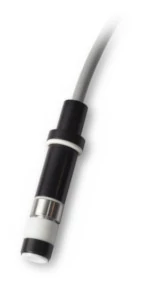
CSOT43 sensors are mainly used to measure and control the oxygen content in the activation tanks of biological WWTPs, in surface, underground and waste water or in fish farming facilities. CSOT43 is a classic Clark type sensor, with robust all-glass two-electrode detection system and a small-area cathode. Compared to modern optical sensors, its advantage is primarily a faster response, as well as the ability to measure very high values.
The P versions are designed for installation into fixed probes, while the L versions are suitable for use with desktop and portable instruments.
- Optimal size of the electrodes and the electrolyte supply ensures perfect linearity, excellent time stability and long maintenance-free operation, without the need for electrolyte replacement, or a third electrode.
- Extremely low oxygen consumption reduces the demands on the flow of the measured water. The sensor can work in virtually any conditions, without additional stirring.
- Smooth surface of the plastic membrane allows self-cleaning of the sensor in flowing water (typical for WWTP activation tanks) and thus lower maintenance requirements.
| Type | Suitable for | Dimensions | Operating and storage temperature |
| CSOT43PS | Installation with SPO41, SPO41K, SPO42, SPO41MEK, PB42V, PB43V, PE G3/4K | Ø14.5 x 57 mm | -5 to +40 °C |
| CSOT43PL | Installation with SPR42, SPR41ME, PE G3/4L, SVK42 | Ø14.5 x 113 mm | -5 to +40 °C |
| CSOT43PSN | Installation with SPO41MEK, PE G3/4K | Ø14.5 x 57 mm | -5 to +80 °C |
| CSOT43S | Installation inside pipes (stainless steel fitting) | Ø14.5 / Ø25 x 127 mm | -5 to +80 °C |
| CSOT43LS | Laboratory measurements | Ø14.5 / Ø18 x 158 mm | -5 to +40 °C |
| CSOT43LZ | Portable instruments (with protective cover) | Ø14.5 / Ø18 x 98 mm | -5 to +40 °C |
| CSOT43LPS | Laboratory, measurements in enclosed units | Ø14.5 x 79 mm | -5 to +40 °C |
| CSOT43LL | Laboratory, measurements in bottles (extended length) | Ø14.5 / Ø18 x 208 mm | -5 to +40 °C |
| Principle | Clark type sensor | ||
| Measurement range | 0.1 - 30 mg/l | ||
| Electrode current | ca 10-8 A (open air, 25°C), ca 10-10 A (N2) | ||
| Response time | ca 15 sec. | ||
| Flow of the sample | min. 2 mm/s (for 1 % output tolerance) | ||
| Materials in contact with medium | Polyethylene terephthalate, PTFE, PP, silicone, stainless steel | ||
